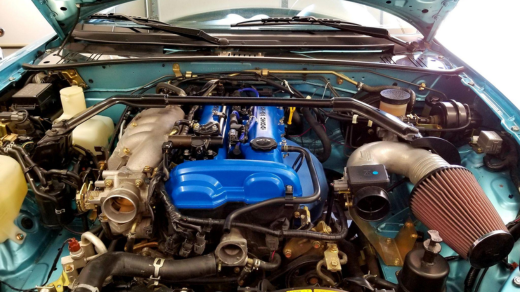The history of performance engineering contains a select few engines that transcend their mechanical nature to achieve legendary status. Mitsubishi’s 4G63 engine stands firmly among these icons. For over three decades, this 2.0-liter turbocharged powerplant pushed the boundaries of what was possible from a relatively small displacement four-cylinder, powering everything from mundane economy cars to world-beating rally champions and helping establish Mitsubishi’s performance credentials on the global stage.
Origins and Basic Architecture
The 4G63 engine traces its roots to the early 1980s as part of Mitsubishi’s “Sirius” engine family. In its most basic form, the engine featured a cast iron block with an aluminum cylinder head, double overhead camshafts, four valves per cylinder, and a displacement of 1,997cc (2.0 liters). This fundamental architecture would remain remarkably consistent throughout the engine’s production life, even as nearly every component was refined and strengthened over time.
What made the 4G63 special wasn’t revolutionary technology or exotic materials but rather exceptionally sound engineering and what seemed like deliberate overbuilding. The block featured a rigid design with thick walls, the crankshaft was forged in most performance applications, and the connecting rods were famously robust—so much so that stock rods could often handle double the factory horsepower ratings.
The Turbo Revolution
While naturally aspirated 4G63 engines powered many Mitsubishi vehicles, it was the turbocharged variant that captured enthusiasts’ imaginations. First appearing in performance-oriented models like the Starion and later the Galant VR-4, the 4G63T (turbocharged) established itself as a formidable powerplant capable of significant output even in stock form.
The introduction of the Lancer Evolution in 1992 marked a watershed moment for the 4G63T. Built to homologate Mitsubishi’s World Rally Championship competitor, the Lancer Evolution combined the potent 4G63T with an advanced all-wheel-drive system in a compact, agile chassis. Through ten generations of Evolution models, the 4G63T remained the heart of the vehicle, though with continuous refinement.
Evolution Through the Generations
The 4G63’s development path provides a fascinating case study in iterative engineering excellence. Between the first application in the Lancer Evolution I and its final appearance in the Evolution IX, the engine underwent numerous changes while maintaining its core identity:
Early 4G63T (Evolution I-III): These engines featured a 6-bolt design where six bolts secured each main bearing cap. Output ranged from 244 to 266 horsepower in stock trim, impressive figures for early 1990s production cars.
Transition Period (Evolution IV-V): Mitsubishi revised the block to a 7-bolt design that altered the main bearing retention system. These engines introduced improved intake manifolds, more sophisticated engine management, and output increased to around 276 horsepower (though this figure was widely believed to be understated due to a Japanese industry gentleman’s agreement limiting advertised power).
Late 4G63T (Evolution VI-IX): The later iterations featured significant improvements to breathing, turbocharger design, and electronic control. The Evolution IX’s MIVEC (Mitsubishi Innovative Valve timing Electronic Control) version represented the zenith of 4G63 development, with variable valve timing enhancing both low-end response and high-RPM breathing. Official output remained at 286 horsepower for the Japanese market, while export versions were often rated higher.
Throughout these generations, the basic displacement and configuration remained unchanged—a testament to the fundamental soundness of the original design. What evolved was the execution and optimization of the concept, with each generation addressing weaknesses and building on strengths.
Engineering Highlights
Several engineering decisions distinguished the 4G63 from contemporary engines and contributed to its legendary status:
Closed Deck Block Design: Unlike many engines with open deck designs, the 4G63’s closed deck architecture provided exceptional cylinder stability under high boost conditions, preventing cylinder wall distortion and maintaining head gasket integrity.
Robust Rotating Assembly: The combination of a forged crankshaft and strong connecting rods provided a foundation that could handle substantial power increases beyond factory specifications with minimal modifications.
Efficient Head Design: The pentroof combustion chamber design with centrally located spark plugs and four valves per cylinder provided excellent combustion characteristics and breathing capability, particularly when combined with aggressive camshaft profiles in later models.
Effective Cooling Passages: The engine featured well-designed cooling channels that prevented hot spots, a crucial consideration for turbocharged applications where heat management directly impacts reliability and performance.
These characteristics helped the 4G63T develop a reputation for “overbuilt” design—not because it contained exotic materials or breakthrough technology, but because its fundamental engineering provided substantial headroom beyond its factory specifications.
Motorsport Legacy
The 4G63’s reputation was cemented on rally stages worldwide. Powering Mitsubishi’s successful World Rally Championship efforts, particularly with driver Tommi Mäkinen who secured four consecutive drivers’ championships (1996-1999), the engine demonstrated exceptional reliability under the most demanding conditions imaginable.
This motorsport heritage directly influenced the production versions, with technology and lessons from competition feeding back into continuous improvement of the street engines. From optimized intake runners to improved turbocharger designs, the connection between racing and production remained tight throughout the engine’s development.
Beyond factory racing efforts, the 4G63 became a favorite in grassroots motorsports, from drag racing to time attack competition. The engine’s robust nature and substantial power potential made it ideal for competitive use, where reliability under stress is as important as maximum output.
Tuning Potential and Aftermarket Support
Perhaps no aspect of the 4G63’s legacy is more significant than its response to performance modifications. The engine became famous for delivering substantial power increases with relatively modest modifications:
Stage 1 Upgrades: Basic intake, exhaust, and engine management changes could reliably yield 300-350 horsepower.
Moderate Builds: With upgraded turbochargers, fuel system enhancements, and supporting modifications, 400-500 horsepower was achievable while maintaining good drivability.
Maximum Effort: Fully built 4G63 engines with strengthened internals, larger turbochargers, and comprehensive supporting modifications have exceeded 1,000 horsepower in extreme applications.
This tuning potential created a massive aftermarket industry with numerous companies specializing in 4G63 performance parts. From basic bolt-ons to complete engine building services, the ecosystem surrounding this engine became one of the most comprehensive in the performance world.
JDM Specifics and Collectors’ Interest
Japanese Domestic Market (JDM) versions of the 4G63 are particularly sought after by enthusiasts worldwide. Imported JDM Mitsubishi engines often feature subtle but important differences from their export counterparts:
Different Turbocharger Specifications: Many JDM engines came with turbochargers featuring unique compressor and turbine wheel designs optimized for Japanese driving conditions and fuel quality.
Engine Management Variations: JDM ECU programming often featured different boost control strategies, ignition timing maps, and fuel delivery calibrations.
Emissions Equipment: Domestic Japanese engines sometimes featured different emissions control systems compared to export versions, occasionally resulting in better flow characteristics or response.
Additionally, JDM engines typically have lower mileage due to Japan’s strict vehicle inspection system and high costs of maintaining older vehicles, making them desirable replacements for enthusiasts restoring or building performance vehicles.
The 4G63’s Cultural Impact
Beyond its technical merits, the 4G63 became a cultural touchstone among automotive enthusiasts. The distinctive sound of its turbocharged exhaust note—particularly with aftermarket systems—became instantly recognizable at car meets and track events worldwide.
The engine’s association with the Lancer Evolution cemented its status in popular culture, with appearances in films, video games, and other media. Games like Gran Turismo introduced countless enthusiasts to the Lancer Evolution and its legendary powerplant, creating new generations of admirers who might never have encountered these vehicles otherwise.
Legacy and Conclusion
Though production of the 4G63 ended with the Lancer Evolution IX in 2007, replaced by the aluminum-block 4B11T in the Evolution X, its legacy continues to influence performance engineering and enthusiast culture. The engine’s combination of robust design, substantial performance potential, and proven reliability set standards that manufacturers still strive to match.
For those who experienced the 4G63 at its peak—whether in a factory Lancer Evolution, a modified street car, or a purpose-built competition vehicle—the engine represents a high-water mark in internal combustion development. More than just a mechanical device, it became a symbol of what dedicated engineering could achieve when performance and durability were prioritized equally.
As the automotive world transitions toward electrification, the 4G63 stands as a reminder of an era when relatively simple, mechanical solutions could deliver extraordinary performance and create passionate followings that transcended national boundaries and lasted for generations.


